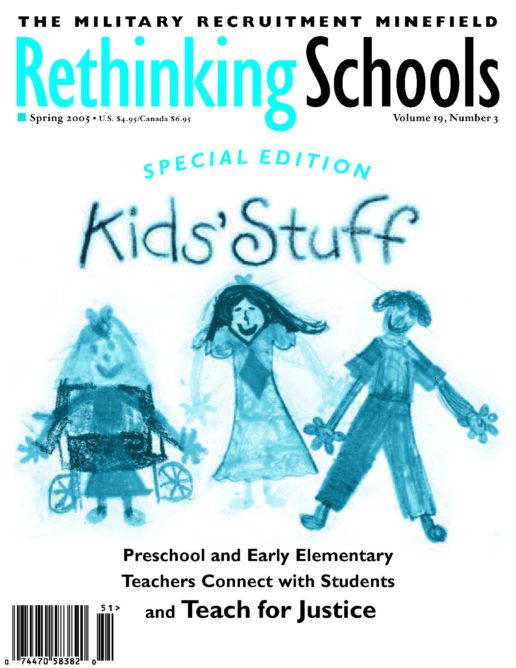What Can One Elementary Teacher In Anytown, U.S.A. Do?
Do not presume that students live in traditional families with both married heterosexual birth parents. Name a wide variety of configurations possible in the diversity of human families. Part of that naming process includes using books and resources that portray family diversity, including the video That’s a Family. [See Resources on Family Diversity] Invite students to respond to the question, “Who is in your family?” Allow students to share and display their family stories and pictures.
Explore and challenge gender stereotypes with your students. Use chil- dren’s books such as Amazing Grace, William’s Doll, Oliver Button Is a Sissy, China’s Bravest Girl: the Legend of Hua Mu Lan, Riding Freedom, and Beautiful Warrior as springboards for discussions. Activities can include students brainstorming lists of stereotypical behavior for boys and girls, then making captioned drawings of boys and girls engaging in non-stereotypical behaviors. These can be made into a class book or hallway display, “Boys Can/Girls Can.” Once students learn to question gender stereotypes, they can recognize and reflect on stereotypical characters and behaviors in other books and media. They can extend their understandings of stereotypes to recognize and challenge other forms of bias.
Teach a lesson on teasing and name-calling. Children’s literature, such as Oliver Button Is a Sissy or The Hundred Dresses can be an excellent point of departure for discussion and activities. These can help establish a baseline of classroom expectations that we are all respected members of this classroom community and that no put-downs will be tolerated.
Answer students’ questions about gay and lesbian issues in a straight forward, educational manner. Do not ignore or quash their curiosity. Remember that the two main points of reference are respecting differences and equality for all people. Elementary children are not asking about sexuality. When they ask what “gay” means, it’s sufficient to say, “Gay is when a woman loves a woman or a man loves a man in a romantic way.”
Replace the phrase “moms and dads” with “parents and guardians” in your classroom and in your school, from informal conversation and classroom teaching to official school documents such as registration forms and emergency cards. Not only is this phrase more inclusive for students with gay or lesbian parents, but also for those being raised by foster parents, grandparents, aunts, and others. It accepts and affirms all of the families in your school.
Consider showing a video like Oliver Button Is a Star as part of a pro- fessional development workshop for faculty and staff. Oliver Button Is a Star is a documentary that weaves a reading and musical production of Oliver Button Is a Sissy with interviews with adults like arctic explorer Ann Bancroft, author/illustrator Tomie dePaola, and dancer Bill T. Jones, who recall their childhood experiences. It includes scenes (some from my classroom) where first and second graders do activities about name-calling and challenging gender stereotypes. That’s a Family and It’s Elementary are good choices too.
In the event that you encounter an intolerant colleague, administrator, or parent, keep the following points in mind:
- The diversity of families in our school is more beautiful and complex than any one of us could presume to know. Whether we have any self-identified (“out”) gay- or lesbian-parented families in our school community or not, it is safer to assume that they are here than not.
- An estimated one in 10 students may grow up to be gay or lesbian adults.
- All of our students deserve a safe and supportive school experience.
- Gays and lesbians are entitled to the same rights as others. We are talking about equal rights, not special rights.
- We are not talking about “sexuality” when we discuss gay and lesbian issues any more than we are discussing sexuality when we read Cinderella or any other story with all heterosexual characters.

